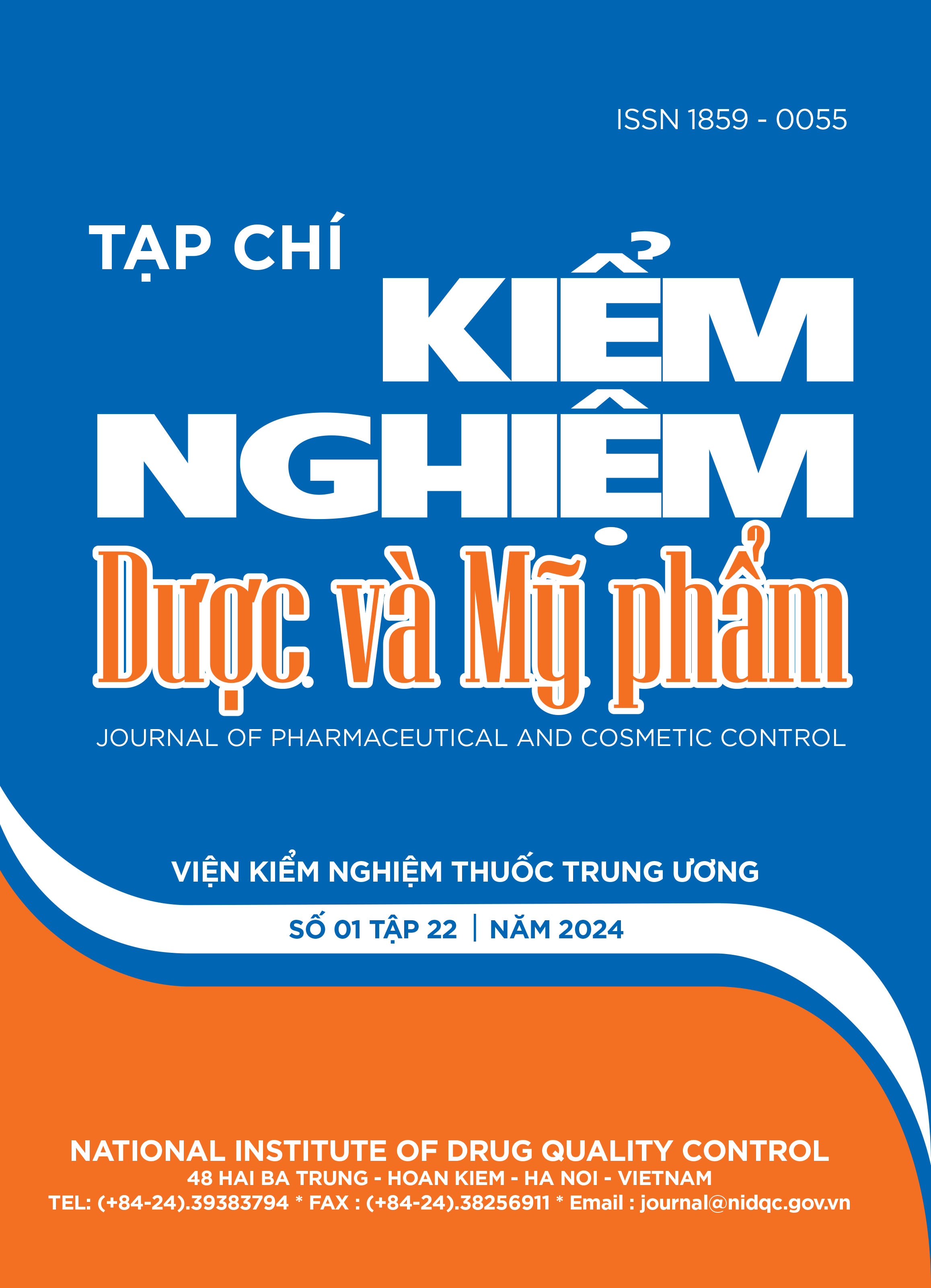Simultaneous determination of three curcuminoids in Tumeric residue
Main Article Content
Abstract
The bisdemethoxycurcumin (BDMC), demethoxycurcumin (DMC) and curcumin are main components of curcuminoid, already well known for their biological activities. In Vietnam, tumeric residues, side product in manufacturing tumeric starch and tumeric oil, still contain important amounts of curcuminoids but rarely exploited to fully making use of their usefulness. In this study, an HPLC method was developed for simultaneously assay of these three compounds in turmeric residue in order to evaluate remaining amount of curcuminoids for further employment. The analytes were completely seperated on a colunm C18 (250 x 4.6 mm, 5 µm) using a mixture of 0.1% solution of phosphoric acid and acetonitril (55 : 45, v/v) as mobile phase with the flow rate maintained at 1.5 ml/min, and UV detection at 425 nm. The method met the requirements of AOAC internationtal guideline for performance of analytical method in term of specificity, linearity, pricision, repeatability, and accuracy. The method was applied to determine curcuminoid content in five tumeric residue samples, finding the total amount of three analytes in these samples varying from 12.5 % to 14.5 % (w/w).
Article Details
Keywords
Bisdemethoxycurcumin, demethoxycurcumin, curcumin, curcuminoids, tumeric residue
References
2. Đỗ Huy Bích và cộng sự (2011), Cây thuốc và Động vật làm thuốc ở Việt Nam, Hà Nội, Nhà xuất bản Khoa học và Kỹ thuật.
3. H. Ahsan, N. Parveen, NU. Khan, SM. Hadi (1999), Pro-oxidant, anti-oxidant and cleavage activities on DNA of curcumin and its derivatives demethoxycurcumin and bisdemethoxycurcumin, Chemico-biological interactions, 121(2), pp. 161-175.
4. B. K. Adams, et al. (2005), EF24, a novel synthetic curcumin analog, induces apoptosis in cancer cells via a redox-dependent mechanism, Anti-cancer drugs, 16(3), pp. 263-275.
5. M. T. Huang et al. (1995), Effects of curcumin, demethoxycurcumin, bisdemethoxycurcumin and tetrahydrocurcumin on 12-O-tetradecanoylphorbol-13-acetate-induced tumor promotion, Carcinogenesis, 16(10), pp. 2493-2497.
6. S. Kumar, U. Narain, S. Tripathi, K. Misra (2001), Syntheses of Curcumin Bioconjugates and Study of Their Antibacterial Activities against beta-Lactamase-Producing Microorganisms, Bioconjugate chemistry, 12(4), pp. 464-469.
7. A. Unlu, E. Nayir, M. D. Kalenderoglu, O. Kirca, M. Ozdogan (2016), Curcumin (Turmeric) and cancer, Journal of BUON: official journal of the Balkan Union of Oncology, 21(5), pp. 1050-1560.
8. T. Nishiyama, et al. (2005), Curcuminoids and sesquiterpenoids in turmeric (Curcuma longa L.) suppress an increase in blood glucose level in type 2 diabetic KK-Ay mice, Journal of agricultural and food chemistry, 53(4), pp. 959-963.
9. N. Kamalakkannan, R. Rukkumani, P. S. Varma, P. Viswanathan P, K. N. Rajasekharan, V. P. Menon (2005), Comparative effects of curcumin and an analogue of curcumin in carbon tetrachloride-induced hepatotoxicity in rats, Basic & clinical pharmacology & toxicology, 97(1), pp. 15-21.
10. K. I. Priyadarsini KI (2014), The chemistry of curcumin: from extraction to therapeutic agent, Molecules, 19(12), pp. 20091-20112.
11. AOAC International (2016), Appendix F, Guidelines for Standard Method Performance Requirements, http://www.eoma.aoac. org/app_f.pdf.
12. H. Soni, S. Patel, N. Govind, S. Ak (2011), Qualitative and quantitative profile of curcumin from ethanolic extract of Curcuma longa, International Research Journal of Pharmacy 2(4), pp. 180-184.


